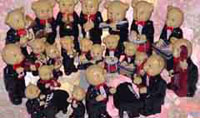Maps and Flags
Above is just a small part of our gift-packed souvenir stamp-collection; inquire by email if the picture or subject of your interest is not here: we will be obliged to accomodate your wishes.
ここに掲載の写真は一部のみです。ご希望のジャンル、絵柄などございましたらお問い合わせください。
地図(ちず)とは、地球あるいは架空の世界の全部または特定の一部分を縮小表現したものである。
書店等で一般的に入手可能な地形図は、東西南北や緯度、経度が指し示されて、等高線による土地の高低差、海、湖、河川のような水域、行政区画、道路や建物の位置などの多くの情報が網羅されている。地図では、記入される情報は全て地図記号で表され、地図の種類または国ごとに統一され決められている。ただし地形図以外のもの(道路地図やガイドマップなど)においてはこのような規格には沿っていないものが多い。
日本では、国土地理院により測量がされて作られている。従来使われてきた測地系(座標を決める基礎情報)が、GPSなどで使われるものと大きく異なっていたため、2002年4月1日に「日本測地系」を「世界測地系」に変更した。その前後の緯度、経度は座標変換が必要になる。
現在では、地図のデジタル化によって、地図上に多くの情報をあわせて持つことができるようになっている(地理情報システム(=GIS)参照)。
A flag is a piece of cloth, often flown from a pole or mast, generally used for signalling or identification. The design of a flag displayed in another form is also referred to as a flag. The first flags were used to assist military coordination on battlefields, and flags have evolved into a general tool for rudimentary signalling and identification, especially in environments where communication is similarly challenging (such as the maritime environment where semaphore is used). National flags are potent patriotic symbols with varied wide-ranging interpretations, often including strong military associations due to their original and ongoing military uses. Flags are used in messaging or advertising, or for decorative purposes, though at this less formal end the distinction between a flag and a simple cloth banner is blurred. The study of flags is known as vexillology, from the Latin vexillum meaning flag or banner.
History
Although flag-like symbols have been used by ancient cultures for thousands of years, the origin of flags in the modern sense is a matter of dispute. Some believe flags originated in China, while others hold that the Roman Empire's vexillum was the first true flag. Originally, the standards of the Roman legions were not flags, but symbols like the eagle of Augustus Caesar's Xth legion; this eagle would be placed on a staff for the standard-bearer to hold up during battle. But a military unit from Scythia had for a standard a dragon with a flexible tail which would move in the wind; the legions copied this; eventually all the legions had flexible standards ― our modern-day flag.
During the Middle Ages, flags were used mainly during battles to identify individual leaders: in Europe the knights, in Japan the samurai, and in China the generals under the imperial army.
From the time of Christopher Columbus onwards, it has been customary (and later a legal requirement) for ships to carry flags designating their nationality; these flags eventually evolved into the national flags and maritime flags of today. Flags also became the preferred means of communications at sea, resulting in various systems of flag signals; see International maritime signal flags.
Beginning in the 17th century, European knights were replaced by centralized armies, and flags became the means to identify not just nationalities but also individual military units. Flags became much more elaborate, and were seen as objects to be captured or defended. Eventually these flags posed too much danger to those carrying them, and by World War I these were withdrawn from the battlefields, and have since been used only at ceremonial occasions.
The above explanation comes from  出典: フリー百科事典"ウィキペディア"
出典: フリー百科事典"ウィキペディア"

